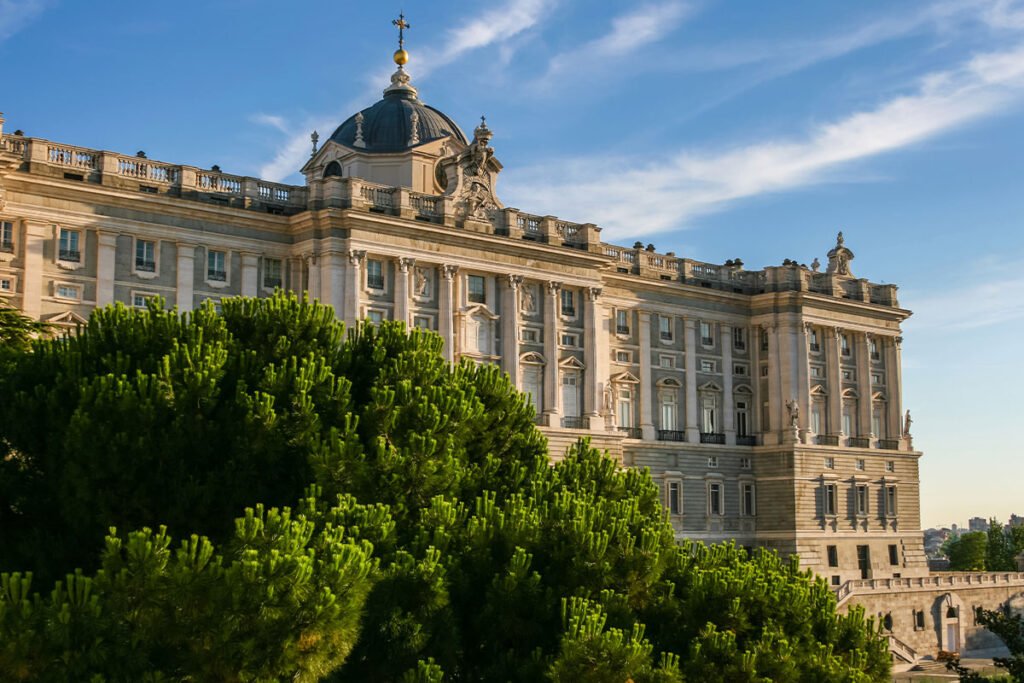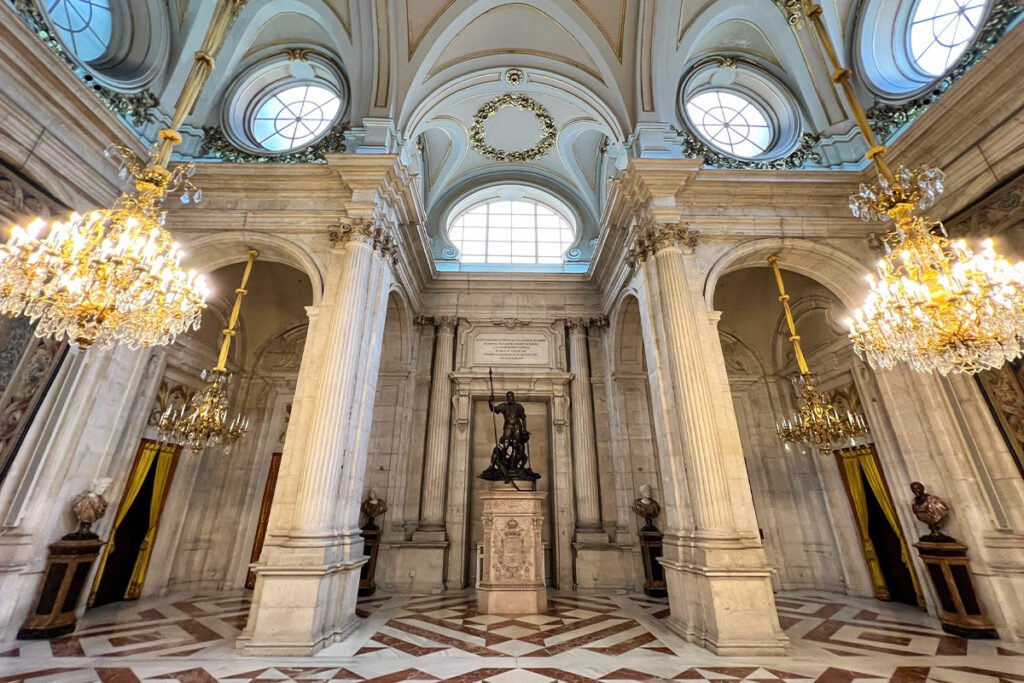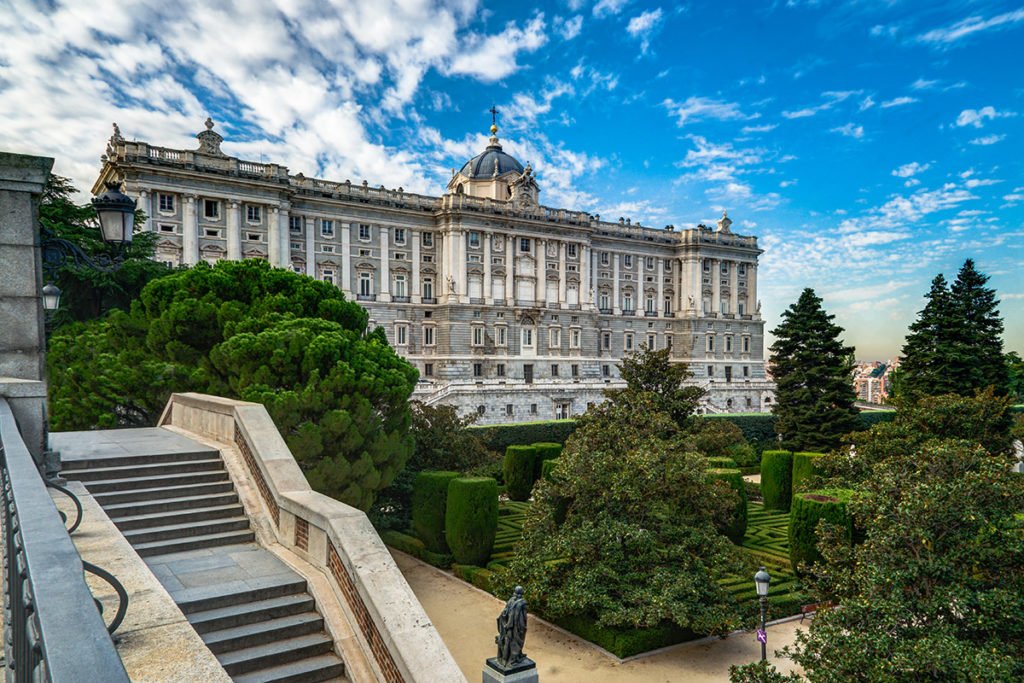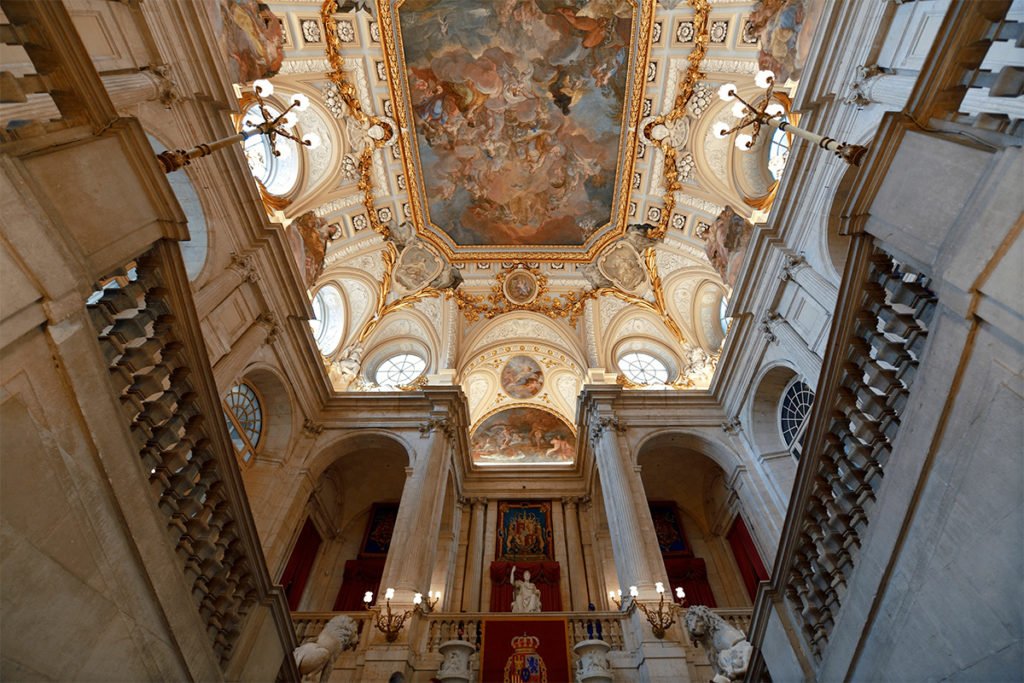If you want to see all of Madrid’s most iconic landmarks during your visit, this historic building must be on your itinerary.
The Royal Palace of Madrid (Spanish: Palacio Real de Madrid), located on Calle de Bailén, is the largest palace in Western Europe and one of the largest in the world. The nooks and crannies of this Baroque building and the works of art hidden in its rooms are discovered by nearly 2 million visitors each year. However, this number will probably not surprise anyone, because it is one of the few official royal residences that are open to the public.
History of the Royal Palace of Madrid
In the place of today’s palace in Madrid, there was originally the Alcázar, a medieval fortress. It was thanks to Henry III, who very often resided within its walls in the second half of the 15th century, that it was nicknamed “royal”. King Henry’s successors began to modify the original structure to resemble a real royal residence. The one who was most concerned about the fate of the later palace was Philip II, who, to give the structure even more class, began to hire outstanding artists from Italy or France for renovation work. Subsequent rulers were quite satisfied with this form of residence, until in 1700 Philip V ascended the throne, who did not particularly love the old medieval fortress.
On Christmas Eve in 1734, a fire broke out in the Alcázar, destroying a large part of the building.
For Philip V, this was an excellent pretext to completely demolish the structure and build a real palace in its place, corresponding to the trends prevailing at that time. Filippo Juvarra, an Italian architect who was considered one of the most talented specialists in Europe, was hired for this task.
However, the master of architecture did not manage to complete the work. He died before the construction work began, and his student, Giambattista Sacchetti, took over the supervision of the construction.
The construction of the structure began in 1738, and it took as many as 21 years to complete it.
The first ruler to inhabit the palace was Charles III, who moved there in 1764.

INTERESTING FACT: Some people believe that members of Philip V’s court deliberately set fire to the old Alcazar so that the king could create a residence more suited to his tastes. There is also mention of the French origin of the courtiers, who wanted to build a palace in the Versailles style close to them.
Today’s face of the Royal Palace
The Royal Palace of Madrid, which is part of the national heritage, is still regularly used by Spanish monarchs to this day. Their audiences and official events with their participation are organized there. It is still the official residence of the King of Spain, although the royal family has not lived there since the time of Alfonso XIII, who died in 1941. The current king and his family now live in the much more modest and smaller Zarzuela Palace (Spanish: Palacio de la Zarzuela), on the outskirts of Madrid.
Visiting the Royal Palace
The Royal Palace in Madrid, which stands in Madrid, has an area of over 135,000 m2.
The building was built on a square plan, and all its wings surround the central courtyard.
There are as many as 3,418 rooms in the palace. That’s twice as many rooms as Buckingham Palace or the Palace of Versailles. What dominates the royal interiors is enormous splendor.
You can be delighted not only with precious materials or noble decorations, but also with the works of great artists, such as Caravaggio, Velázquez and Goya. The style of the palace was actually shaped by the tastes of the monarchs who inhabited it. So let’s see what trends fell into the hearts of the personalities ruling Spain.
Throne room
The Throne Room (Spanish: Salón del Trono) was completely completed in 1772 and today you can still see the decorations in exactly the same arrangement as during the reign of Charles III.
And this king did not spare any money to arrange the room in which he received all the solemn audiences. He even hired a man specializing in matters of good taste to design the layout of the room. Entering this room, it is worth paying attention to Tiepolo’s work “The Greatness and Power of the Spanish Monarchy”, as well as a copy of the throne set in the central part of the hall, surrounded by statues of Apollo and Minerva.
Royal Armory
It would seem that the throne room is the most important room you can see during a tour of the Royal Palace, but this armory interior is the most frequently visited by tourists. However, this is no ordinary armory, but the most important collection of this type in Europe (on a par with the Imperial Armory in Vienna), both due to the value of the elements stored there and their historical significance. The father of this collection was Philip II, who began to collect weapons and forbade selling their elements after his death, thus linking future exhibits with his son and his successors.
The collection, which consists of elements dating from the 15th century and later, has only occupied the present room since 1893. Its most valuable element is the complete armor of Emperor Charles V from the Battle of Mühlberg. This is the same armament in which he was portrayed by Titian in the painting that is now in the Prado Museum.
Column Hall
And here, until the reign of Isabella II, royal balls and banquets were held. And this room probably did well in this role, because it is still used today to organize receptions, award ceremonies or meetings of ambassadors. The columns topped with capitals with golden fleece really attract attention, but they are not the ones playing first fiddle in the hall. However, it is difficult to decide whether this title belongs to the unusual vault, impressive, huge chandeliers, or the statues surrounding the hall.
Halberdiers’ Hall
The history of this place is quite interesting. Sacchetti created this place as a hall for dances and receptions, but Charles III turned it into a room for the guard. That is why its decorations are visibly more modest than those that diversify other rooms. But don’t worry, there is something to feast your eyes on. The vault of this room is decorated with a fresco by Tiepolo, referring to mythological themes, but the biggest impression is made by the large painting “The Family of Juan Carlos I”, recently placed in this room, by the contemporary painter Antonio López García.
Gasparini’s Chamber
Who was Gasparini? It is under this name that the creator of the decoration of this room is hidden. The chamber was a place where the king received special audiences, so it is not surprising that he wanted to decorate it with special care. Mattii Gasparini came all the way from Naples to take care of this task, but it was worth it, because thanks to this, not only one of the most magnificent rooms of this palace was created, but also one of the most perfect international works of the late European Baroque.

Furniture, walls, floors and all the materials used for finishing create the whole project of the hall. According to the assumption, everything was supposed to harmonize with each other and every visitor can see for themselves, because the interior has survived to this day practically without any changes.
The remaining rooms of the palace in Madrid
Among the palace corridors, there are of course many more rooms worth attention. Some of them are:
- Royal Library – the royal library collection contains about 300,000 printed works, both ancient and contemporary, as well as manuscripts, musical works, maps and drawings.
- Royal Kitchen – 2000 m2 of space is the area of the former kitchen, where today 2625 objects used to prepare meals worthy of a royal palate are exhibited.
- Royal Dining Room – state dinners are held there to this day. The hall surprises with its length, and this is because it is the result of combining three rooms previously occupied by the queen. The walls of this room are covered not only with tapestries, but also with masterpieces by Francisco Goya himself.
- Royal Chapel – decorated with unusual frescoes and ornaments. It houses the relics of Saint Felix, whose image in the form of a wax sculpture can be seen in a glass sarcophagus.
Gardens worthy of a royal family
After completing the visit to the palace interiors, it is worth taking a walk in the fresh air – preferably in the gardens surrounding the royal residence. On the north side, the Sabatini Gardens adjoin the building, which were created in the 1930s. In their area, you cannot miss the main pond, fountains or statues of Spanish kings, which were originally intended to crown the Royal Palace. The main attraction for botany lovers will most likely be the flower beds adorning the garden, the precisely trimmed hedge and the huge cedar trees.

To the west of the royal estate there are also the Campo del Moro Gardens, the creation of which is owed to Philip II. It was he who first created a park there with over 20 hectares and serving as a recreational area for the court in Madrid, but after the fire of the Alcazar it was completely neglected.
It was not until the reign of Isabella II that it was restored to its former glory and an intimate garden was opened, organized around two main avenues and decorated with two fountains. This place is devoid of mass tourist traffic, so you can relax here, or sit in an atmospheric restaurant.
Interesting concerts are also often held in the gardens. It is a pity not to take advantage of such an opportunity, especially since admission to Campo del Moro and the Sabatini Gardens is free and is not dependent on a visit to the Royal Palace.
Practical info
- It is best to buy tickets to the Royal Palace of Madrid in advance. This will prevent you from standing in a long line and you will avoid the risk of all tickets being sold out.
- Address: Calle de Bailén, s/n, 28071 Madrid, Spain
- Buy Tickets on GetYourGuide

